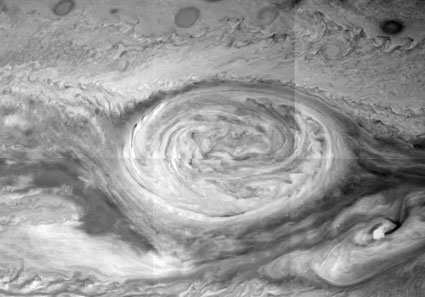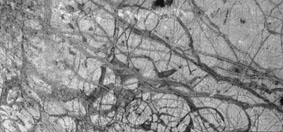J. Brit. Astron. Assoc., 106, 5, 1996 (pp 239–240)
Despite the loss of its main antenna, the NASA/JPL spacecraft Galileo has begun returning superb images of Jupiter and three of its largest moons. Difficulties with the on-board tape recorder were overcome by skilful software manipulation by NASA technicians. A world-wide network of receivers, including the Parkes radio telescope in Australia, has been adapted to capture the feeble signals from the backup antenna (see Astronomy Now, 1996 September). A selection of the early images is presented here, on the cover, and in colour below.

This is a mosaic of six images taken through the near-infrared (756µm) filter over 80 seconds on 1996 June 26, starting at 04.20 UT. South is at the top, for ease of correlation with amateur Earth-based views. John Rogers comments: 'The internal circulation of the GRS, and the billowing clouds in the turbulent SEB (bottom right), look very much as they did in the Voyager images. The whitened STB (along top) and SEBZ (bottom left) have different textures of white clouds, which in both cases look as if they are being blown along above the dark 'trough' bordering the GRS.' Later information from NASA suggests that these and other images are already providing new insights into the mechanisms driving this massive 20,000km storm.
'These images have exceeded our wildest expectations', said Dr Michael Belton (NOAO), head of the Galileo Imaging Team. The first image shows the same area of the satellite as recorded by Voyager(left) and by Galileo on its first flyby, June 27, at a distance of 7,448km. Voyager showed numerous grooves a few kilometres wide, but the Galileo images resolve each groove into narrow striations in the icy surface. The resolution is approximately 74m (243 feet) per pixel, more than 17 times better than that of Voyager.
Other images yield surprising new information about the satellite's geological past. Galileo Regio and Uruk Sulcus show ancient cratered ice fields, adjacent to or overlain by younger ice volcanic plains, ridged ice mountains, deep furrows and smooth broad basins that are products of tectonic forces. About half of Ganymede's older cratered surface appears to have been resurfaced by younger volcanic and tectonic activity.
Instruments on the spacecraft have shown that Ganymede possesses its own magnetosphere, the first time such a halo of charged particles has been found round a satellite rather than a planet. The finding indicates that Ganymede, which is three-quarters the size of Mars, may create its own magnetic field. According to NASA, possible sources of a magnetic field could include a molten iron core, or even a thin layer of conducting salty water under the satellite's icy crust. The plasma wave spectrometer also showed that the densities of charged particles around Ganymede increased by a factor of more than 100 near Galileo's closest approach, about 835km from the moon. This has been interpreted as indicating that Ganymede is surrounded by a thin ionosphere, and may also have a tenuous atmosphere.

Part of the equatorial zone of Europa imaged from a distance of 156,000km. North is to the right and the Sun almost directly overhead.
The first images of Europa from Galileo, taken on June 27 during the Ganymede flyby, repeat the Voyager findings of a cracked, icy crust, like massive Arctic ice-floes on the Earth. Unlike most other bodies in the solar system there is little evidence of cratering. The cracked, cue-ball appearance is believed to be due to stressing caused by the tidal effects of Jupiter's strong gravity, and warmth generated by tidal heating may be sufficient to soften or even liquefy some of the moon's icy covering. Dr Ron Greeley (Arizona State University) said 'We're seeing a lot of evidence of geological activity on Europa. In some areas, the ice is broken up into large pieces that have shifted away from one another, but obviously fit together like a jigsaw puzzle. This shows the ice crust has been or still is lubricated from below by warm ice or maybe even liquid water.'
The current images, taken from a distance of about 155,000km (95,700 miles) have a resolution of about 1.6km per pixel. Later flybys will take Galileo to within 600km (370 miles) of Europa's surface, when objects as small as 11 metres (36 feet) may be resolved.
 [~26 Kb]
[~26 Kb]
Comparison of Galileo images taken from 2.24 million km (1.4 million miles) on June 25 with full-colour images returned by Voyager show many changes on the surface of this volcanically active, sulphurous world.
Further flybys by Galileo of the moons of Jupiter are scheduled for 1996 September 6 (Ganymede, at 250km), December 19 (Europa, 600km) and 1997 February and November. Additional observations at greater distances are also planned.
Hazel McGee
This report was compiled from bulletins available on the World Wide Web at http://www.jpl.nasa.gov/galileo with valuable assistance from John Rogers, Director, Jupiter Section.
Back to top of page
Return to Journal 1996 October contents page